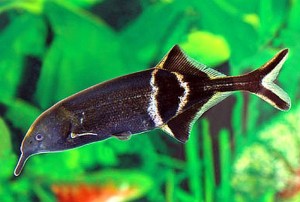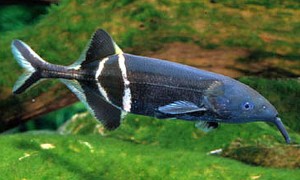Elephantnose Fish (Gnathonemus petersii) are widely distributed throughout Africa in Mali, Benin, Niger, Nigeria, Chad, Central African Republic, Cameroon, Republic of Congo, Democratic Republic of Congo and Zambia.
They are a largely nocturnal, scaleless fish that inhabit the dark muddy beds and heavily vegetated areas of slow flowing rivers where they root around the substrate for small worms and crustaceans.
The Elephantnose Fish, also known as Peter’s Elephantnose, is the most common Mormyrid known to tropical fish keeping enthusiasts and probably the most abused. This is one species that must have a mud or sandy substrate in their aquarium and should never be kept in a tank with gravel.
Peter’s Elephantnose uses its “trunk” or proboscis to locate food hidden in the substrate. It also needs to be housed under dim lighting. When it is kept under bright aquarium lighting, they become withdrawn and will eventually waste away.
Elephantnose Fish are scaleless and sensitive to salt and most aquarium medications. They are also extremely sensitive to deteriorating water quality and are used in many European municipal water supplies to flag deteriorating water conditions. Like other Mormyrids, they produce a weak electric field using specially adapted muscle tissue located near the fish’s tail. As the water quality deteriorates and becomes more polluted, the frequency of their electrical discharges increases, signalling poor water quality.
Gnathonemus petersii are colored black to dark gray with two white vertical V shaped lines that run from their rear set dorsal fin down to their anal fin. They have a downward pointing fleshy “nose” or proboscis that they use to burrow around in the substrate for worms.
In addition to the specially adapted muscle tissue at their tail, they also possess electroreceptors that allow them to receive electrical signals through the water column. When the electrical field they generate is disturbed around them, they can sense the most minute movement in the water. This adaptation is used for communication, finding mates, and for locating their food.
Although some tropical fish keeping enthusiasts suggest that the shape of the anal fin can determine the sex of Peter’s Elephantnose, there is no accurate visible external way to differentiate between sexes.
Elephantnose Fish have very large brains for their size, with three different electroreceptors that carry information to the fish in total darkness. They are able to differentiate between different species and even determine the sex of conspecifics to find mates, all in total darkness.
Elephantnose Fish are quiet but somewhat territorial species. They do not mix well with other Mormyrids nor should they be housed with aggressive or very active fish. Unless they are housed in an African single species biotope setting, they should not be kept in pairs. There is a tendency for one fish to bully the other fish to death. If more than one fish is to housed together, a minimum of 5 specimens is recommended in a large tank to keep aggression to a minimum.
In a community tank setting, they can be kept with other African species such as Congo Tetras, Synodontis catfish, smaller Bichirs, African Butterfly Fish, peaceful cichlids like Geophagus, Angelfish, or Satanoperca and Ctenopoma species.
Elephantnose Fish are best kept in densely planted 55 gallon or larger aquarium with only a muddy or sandy substrate (NO gravel), some African Driftwood, some smooth river rock made into caves and plenty of hiding places. Being nocturnal, they need minimal lighting so low light loving plants like Java Fern
, Java Moss
, Anubias spp.
and Vallisneria can be used to aquascape the tank.
A few floating plants
will also help diffuse the lighting in the tank. A sand substrate is critical to the well being of this species. When it feeds, it burrows into the substrate with it’s fleshy proboscis like lower lip and when regular aquarium gravel is used, the coarse substrate usually damages their mouth prohibiting it from feeding naturally.
Finally, a good filtration system is needed along with regular partial water changes to maintain water quality and the health of these fish.
To date, no successful spawning has occurred in an aquarium environment. It is believed that keeping the fish confined causes their electrical impulses to become less defined and that they cannot recognize members of the opposite sex.
Most Elephantnose Fish are not fussy about eating and will accept a wide range of fresh, frozen or freeze dried foods. They are particularly fond of live tubifex but will eat many other types of meaty foods such as bloodworms, chopped earthworms, brine shrimp, and blackworms. If you cannot provide suitable lighting for these fish to feed during daylight hours, feed them just before you turn the lights out on the tank at night so they can get their share.
Elephantnose Fish are usually available at most tropical fish shops and online. They are usually sold when they are between 4″ and 6″ in length.
Minimum Tank Size: 55 gallons
Care Level: Moderate
Temperament: Semi-aggressive
Aquarium Hardiness: Hardy
Water Conditions: 73-82° F, 5-15°H, pH 6.0-7.5
Max. Size: 9″
Color Form: Black
Diet: Carnivore
Compatibility: Peaceful Community Tanks
Origin: Africa
Family: Mormyridae
Lifespan: 6-10 Years
Experience Lever: Intermediate




2 Responses to “Elephantnose Fish (Gnathonemus petersii)”
Trackbacks/Pingbacks
[…] picky and hard to feed species like elephant nose fish, rope fish, Axolotls, Discus, etc. apparently love the taste of live tubifex worms, however as […]
[…] the aquarium, the Ich parasite can be eliminated without harming more delicate species like such as elephantnoses and […]